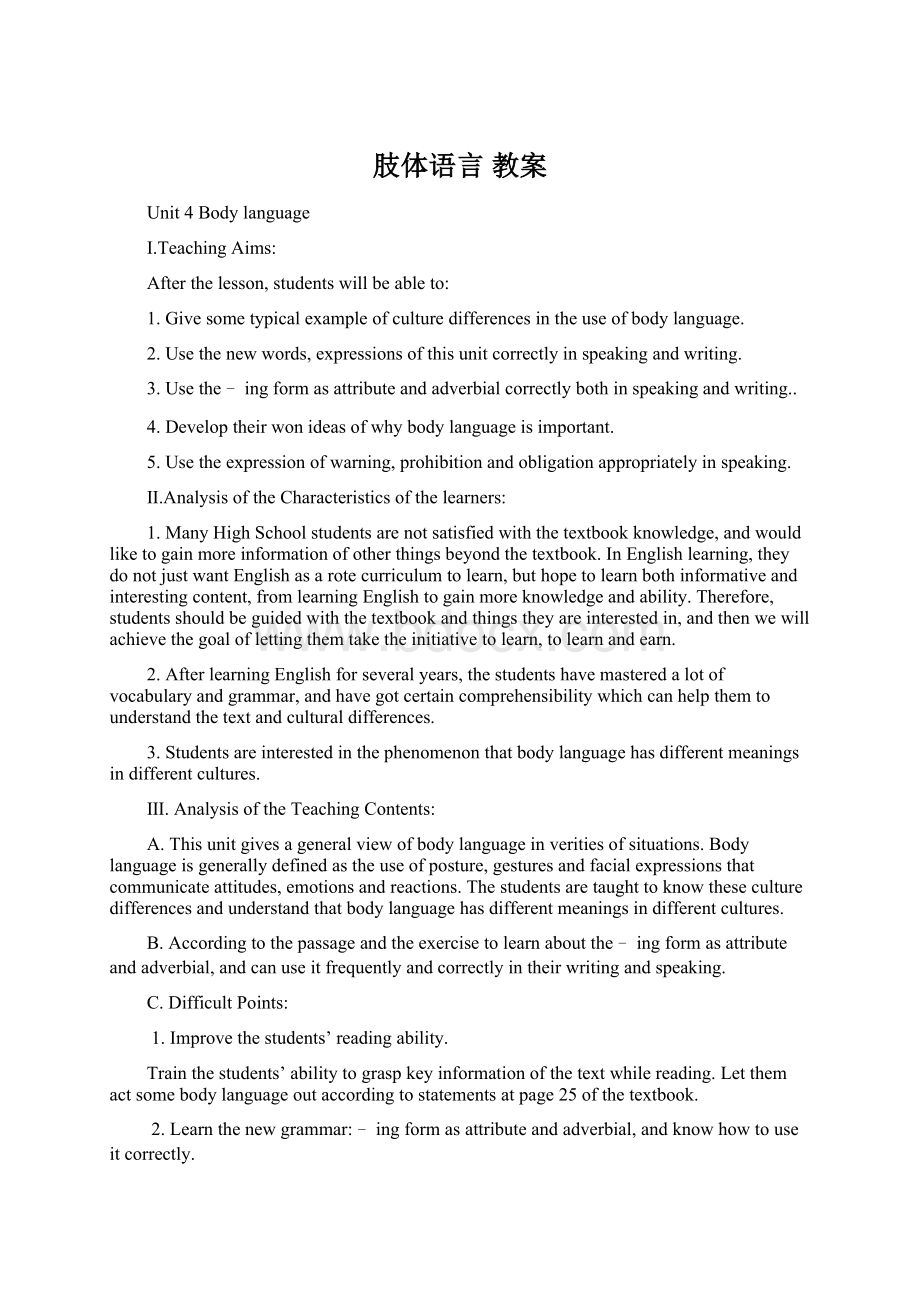肢体语言 教案.docx
《肢体语言 教案.docx》由会员分享,可在线阅读,更多相关《肢体语言 教案.docx(7页珍藏版)》请在冰豆网上搜索。

肢体语言教案
Unit4Bodylanguage
Ⅰ.TeachingAims:
Afterthelesson,studentswillbeableto:
1.Givesometypicalexampleofculturedifferencesintheuseofbodylanguage.
2.Usethenewwords,expressionsofthisunitcorrectlyinspeakingandwriting.
3.Usethe﹣ingformasattributeandadverbialcorrectlybothinspeakingandwriting..
4.Developtheirwonideasofwhybodylanguageisimportant.
5.Usetheexpressionofwarning,prohibitionandobligationappropriatelyinspeaking.
Ⅱ.AnalysisoftheCharacteristicsofthelearners:
1.ManyHighSchoolstudentsarenotsatisfiedwiththetextbookknowledge,andwouldliketogainmoreinformationofotherthingsbeyondthetextbook.InEnglishlearning,theydonotjustwantEnglishasarotecurriculumtolearn,buthopetolearnbothinformativeandinterestingcontent,fromlearningEnglishtogainmoreknowledgeandability.Therefore,studentsshouldbeguidedwiththetextbookandthingstheyareinterestedin,andthenwewillachievethegoaloflettingthemtaketheinitiativetolearn,tolearnandearn.
2.AfterlearningEnglishforseveralyears,thestudentshavemasteredalotofvocabularyandgrammar,andhavegotcertaincomprehensibilitywhichcanhelpthemtounderstandthetextandculturaldifferences.
3.Studentsareinterestedinthephenomenonthatbodylanguagehasdifferentmeaningsindifferentcultures.
Ⅲ.AnalysisoftheTeachingContents:
A.Thisunitgivesageneralviewofbodylanguageinveritiesofsituations.Bodylanguageisgenerallydefinedastheuseofposture,gesturesandfacialexpressionsthatcommunicateattitudes,emotionsandreactions.Thestudentsaretaughttoknowtheseculturedifferencesandunderstandthatbodylanguagehasdifferentmeaningsindifferentcultures.
B.Accordingtothepassageandtheexercisetolearnaboutthe﹣ingformasattributeandadverbial,andcanuseitfrequentlyandcorrectlyintheirwritingandspeaking.
C.DifficultPoints:
1.Improvethestudents’readingability.
Trainthestudents’abilitytograspkeyinformationofthetextwhilereading.Letthemactsomebodylanguageoutaccordingtostatementsatpage25ofthetextbook.
2.Learnthenewgrammar:
﹣ingformasattributeandadverbial,andknowhowtouseitcorrectly.
ImportantPoints:
a).Thenewwordsandexpressions.
b).Learnsomedetailedinformationabouttheculturedifferencesinbodylanguage.
c).Trainthestudents’abilitytocooperatewithothers,andshowtheirideasexactly.
d).Trainthestudents’discussability.
Ⅳ.TeachingProcedures:
1.Warmingup,Pre-reading,Fastreading.
2.Reading,Textanalysesandlanguagepoints.
3.Grammar,learningaboutlanguage.
4.Usinglanguage.
5.Revision,exercise.
Ⅴ.Teachingmethodology:
1.CommunicativeApproach(CA)
Or(CommunicativeLanguageTeaching=CLT).
2.Task-basedLanguageTeaching.
3.CognitiveApproach.
Ⅵ.LearningStrategy:
CooperativeLearning;
AutonomousLearning.
Ⅶ.Teachingplan:
Unit4BodyLanguage(Reading,TextAnalysesandLanguagepoints.)
Step1ChecktheComprehendingAnswers(5minutes)
Thestudentsareleftthehomeworktoreadthetextandgainthemainideasandfinishedtheexercise1andexercise2.
Checktheanswersanddosomecorrections.
KeytoExercise1:
Name
Description
BodyLanguage
Towhom
TonyGarcia
manformColombia
kissonthecheck
everyone
JuliaSmith
womanformBritain
notouching
everyone
AkiraNagate
manformJapan
bowing
everyone
GeorgeCook
manformCanada
shackinghands
everyone
AhmaedAziz
manformJordan
shackinghands
nodding
toman
towoman
DarleneCoulon
womanformFrance
shackhandsandkisstwiceoneachcheek
peoplesheknows
SuggestedanswerstoExercise2:
1.Theauthorismale.AhmedAzizwillnotshakehandswithwoman,hutheshakehandswiththeauthor.(par.3)
2.HenoticedthattheColombianmankissedtheBritishwoman,butinherculture,akissformastrangerisnotacceptable.HealsonoticedthattheJapanesemanbowedjustastheCanadianmanstartedtoshakehands,sooneman'snosetouchedtheotherman'shand.(par.2)
3.TheBritishwoman,Julia,andprobablytheCanadianman,George,seemedtoprefertokeepmorephysicaldistanceformothers.TheColombianman,Tony,andtheJordanianman,Ahmed,seemedtoprefercloserphysicaldistance.(par.2&par.3)
4.Yes.TonyformColombiaandDarleneformFrancehadasimilargreetingcustom–akiss.GeorgeformCanadaandAhmedformJordanalsohandasimilargreetingcustom–ahandshake,butAhmedshakeshandsonlywithman.(par.4&par.2&par.3)
5.Thissayingmeansthatwhenweareinacertainplace,weshouldfollowthecustomsofthepeoplewholivesinthatplace,notourowncustoms.
6.Studentswillgivetheirownanswers.
Step2DiscusstheExercise3(5minutes)
Dividethestudentsinto4groups;letthemdiscussoneofquestionsofexercise3.
Exercise3
1.Sampledialogue:
S1:
Iwouldfeelmostuncomfortableifsomeonecametoclosetomeandaskedmeforinformation,wouldn’tyou?
S2:
Metoo!
AtfirstImightthinkthathemeanttoattackmeorstealsomethingformme.Butofcoursesomecountriesdogetveryclosetoeachother.IknowthattheydothisinArabcounties.
S1:
Theydo,butnotwithwoman!
S2:
True.Ithinkit’sthepartoftheworldwherewomanhavetokeepthemselvesoutofsight.
S1:
SothemanmightbefromanyArabcountry.ItmightbeSaudiArabia,YemenorJordan.
S2:
Right.I’llrememberthat!
2.Sampledialogue:
S1:
Ifthathappenedtome,I’dthinkthatthemanwasveryrude.
S2:
Yes,butinthiscaseIthinkthatthemanthinksthatYOUarerude!
S1:
Why?
S2:
Becauseit’snotconsideredproperforwomantowearshortsinpublic.Youaresupposedtocoveryourselfup.
S1:
Isee,butwhatabouttheshoes?
S2:
YouhavetotakeyourshoesoffwhenyougointoanArabhouse.It’spoliteandpartoftheirreligion.Soit’snicetoshowrespectforthemandfollowtheircustoms.
S1:
NowIunderstand.IfIwerethegirl,I’dtakemorecarenexttime.
S2:
Thatexcellent!
Step3Textanalysesandlanguagepoints(35minutes)
1.Yesterday,anotherstudentandI,representingouruniversity’sstudentassociation,wenttotheCapitalinternationalAirporttomeetthisyear’sinternationalstudents.昨天,我和另一个学生代表我们学校的学生会,到首都国际机场迎接今年的国际学生。
a.represent(vt.)
1)standfororbeasymbolorequivalentof(sth/sb);symbolize代表;象征;标志
WhatdoesthebiggeststarrepresentintheRedFlagwithFivestars?
五星红旗上最大的那个星星代表什么?
ItrepresentsChineseCommunistParty/theCommunistPartyofChina.
2)beanexampleof(sth)是(某事物)的一个例子
Thisdesignrepresentsamajornewtrendinmodernart.这种设计反映了现代艺术中的一种主要趋向。
b.representingouruniversity’sstudentassociation在句中做伴随状语
Thechildrenranoutoftheroom,laughingandtalkingmerrily.孩子们有说有笑地跑出了房间。
Mr.Smithsatatthewindowreadinganewspaper.史密斯先生坐在窗边看报纸。
c.association(n.)
1)anofficialgroupofpeoplewhohavejoinedtogetherforaparticularpurpose协会;社团;联盟
NBANationalBasketballAssociation
2)~(withsb/sth)aconnectionorrelationbetweenpeopleororganizations联系;关联;交往
Therehasbeenacloseassociationbetweenthesetwocompanies.这两个公司之间一直有着密切的联系。
3)anideaoramemorythatissuggestedbysth/sb联想
Theseasidehadallsortsofpleasantassociationswithchildhoodholidaysforme.海滨使我想起童年假期的各种愉快情景。
2.…Isawseveralyoungpeopleenterthewaitingarealookingaroundcuriously.……我看见几个年轻人走进了等候区,好奇地四处张望。
a.lookingaroundcuriously在句中做伴随状语
b.curious(adj):
eagertolearnorknow富于好奇心的;有求知欲的;感兴趣的。
curiously是它的副词形式。
1)Asalittlegirl,shewascuriousabouttheoriginofhumanbeings.他还是个小女孩儿时,就对人类的起源产生了兴趣。
2)Thetouristsweresurroundedbythecuriouschildren.游客被好奇的孩子们围起来了。
3)Curiouslyenough,Ididn’tfeelatallnervouswhenIfacedtheaudience.令我好奇的是,当我面对观众的时候一点儿都不感觉紧张。
3.TonyapproachedJulia,touchedhershoulderandkissedheronthecheek!
托尼走近朱莉亚,摸了她的肩,吻了她的脸!
approach(verb&noun)
a.verbtocomeneartosb/sthindistanceorintime(在距离或时间上)靠近;接近
Weheardthesoundofanapproachingcar/acarapproaching.我们听见一辆车驶近的声音。
Winterisapproaching.冬天就要来临。
Asyouapproachthetown,you’llseethecollegeontheleft.快到市镇时就可以看到左边的学院。
b.noun
1)apath,road,ect.thatleadstoaplace小径;道路
Alltheapproachestothepalacewereguardedbytroops.通往宫殿的所有道路都有军队守卫。
2)awayofdealingwithsb/sth;awayofdoingorthinkingaboutsthsuchasaproblemoratask(待人接物或思考问题的)方式,方法,态度
Theschoolhasdecidedtoadoptadifferentapproachtodiscipline.校决定采取另外一种方式解决纪律问题。
Shetookthewrongapproachinherdealingwiththem.她用错误的手段和他们打交道。
4.Shesteppedbackappearingsurprisedandputupherhands,asifindefence.(她后退了几步,看上去有些吃惊,并举起了手,好像是在自卫。
)
a.appearingsurprised在句中做伴随状语.Appear在剧中意思是seem。
Itappearsthatyouweregiventhewronginformation.(你似乎得到了错误的信息。
)
Heappearedtobeafoolinthedancingball.(他在舞会上像个傻子似的。
)
c.defence(n):
protection(=<美>defense)防卫;防备;防护。
这个词可分为可数不可数形式,其意义有所不同。
不可数名词代表防卫的行为(action),可数名词表示可以用来防卫的东西(something)。
insb's/sth'sdefence是词组,表示“在……的防卫下”。
Theywerebraveindefence.他们勇敢防守。
Theysaythatthetwomenwereactinginself-defence.他们说这两人在自我防卫。
Isthereanymanunwillingtofightindefenceofhiscountry?
难道有谁不愿为保卫国家而战吗?
5.Iguessedthattherewasprobablyamajormisunderstanding.我猜想这里可能有个大误会。
a.that做guess的宾语,引导宾语从句。
b.major用作形容词,表示moreimportant;great(er)(较)重要的;(较)大的;主要的
amajorroad大路;干道
Thecarneedsmajorrepairs.这辆车需要大修。
c.major用作动词时,表示specializeinacertainsubject(atcollegeoruniversity)主修(大专院校)科目
DaisyismajoringinFrench.黛西主修法语。
d.major用作名词时,表示armyofficerbetweenacaptainandalieutenantcolonel陆军少校
6.Whenwemetyesterday,hemovedveryclosetomeasIintroducedmyself.我们昨天见面,我进行自我介绍时,他靠我很近。